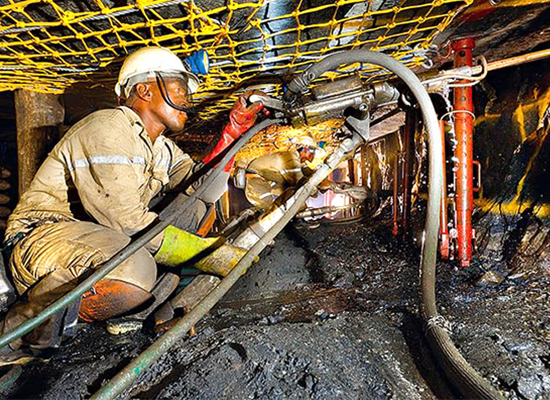
The first phase of the Countrywide Airborne Geophysical Survey ended in June 2021 and the Mineral Rights Board is in the process of ending a six-year-long moratorium on exploration licenses.
The survey covered Migori, Homa Bay. Kakamega, Busia and Siaya counties and was conducted by the Minis-try of Mining in partnership with the Ministries of Interior and Defense. It is estimated that there are close to 200 firms seeking exploration licenses.
Kakamega
Following the survey’s conclusion, Kakamega County Government handed over 14 acres of land to the Ministry of Petroleum and Mining for establishment of a gold refinery.
The refinery will add value to mining activities in Kakamega County and the Lake Region Economic Bloc. According to the first phase of the Countrywide Airborne Geophysical Survey, high value gold deposits exist in Ushiuru, Bushiangala and Rostaman areas of Kakamega County.
The county has the oldest mining sites dating back to 1930 alongside the counties of West Pokot, Samburu, Narok, Turkana, Nandi, Siaya, Migori, Homabay and Marsabit.
In 2014, President Uhuru Kenyatta issued a Presidential directive to the State Department of Mining to en-sure promotion of value addition in the mining sector. In the Presidential directive, several minerals were targeted including soapstone processing in Kisii County, granite processing in Vihiga and gemstone in Taita Taveta County,” Governor Oparanya noted. The proposed site of the refinery will have a processing plant to separate gold from the ore, a refinery to purify the gold, an office block and an office centre, an ICT Centre, a Health Centre and a training facility,” he added.
Nyanza
The State Department of Mining is implementing a programme to empower and avoid exploitation by unscrupulous investors eying a slice of the rich natural resource.
Limestone mining for cement production has taken root in Kisumu and its environs. The sensitisation programme seeks to build the capacity of the community on the existing legal framework and ensure that the investors operate within the set regulations. The aim is to ensure that mining activities are carried out procedurally according to the Cement Minerals Levy Regulations Act 2013, to generate revenue for the government and benefit the local community.
The Mining Department has partnered with the County Government of Kisumu and other stakeholders to conduct public participation sessions in Koru and Muhoroni areas of Kisumu County and other parts of the region where limestone mining is ongoing. The department has also joined hands with the National Environment Management Authority (NEMA) to ensure a proper environmental impact assessment is carried out before mining is authorised.

At the same time artisanal miners in the region have been urged to employ safety measures while carrying out mining.
Committees have also been created in areas where gold mining takes place to ensure that safety guidelines are observed to curb incidences of loss of lives. Other than limestone and cement production minerals like copper and gold in Siaya are also being targeted.
The Directorate of Resource Surveys and Remote Sensing is mandated to collect, store, analyse, update and disseminate geo-spatial information on natural resources, including land use and land cover mapping
Coast Region
In May 2021, the Kwale-based Australian mining firm Base Titanium signed its first ever mining contract with the local communities in Kwale and Mombasa counties. The Community Development Agreements (CDAs), a requirement under the Mining Act, commits Base Titanium to support local community development programmes.
Local communities can now get funding from the mining firm for development projects tailored to their needs. It followed consultations with the communities’ leaders to ensure their sustainable development and growth.
The Mining Act, among other things, introduces the sharing of mining royal-ties between the National and County governments and local communities, with the National Government taking 70 percent, County 20 percent and local communities 10 percent. The agreement will see about KSh250 million shared annually between the CDAs in the Kwale and Mombasa counties.
The Government sees such CDAs as a progressive approach to addressing the endemic challenges in communities living in areas where mining is undertaken.
In the historic agreement the firm simply known as ‘Base’ which carries out large scale mining activities in Msambweni sub county of Kwale is obligated to remit one percent of their total earnings accrued from minerals exploitation.
The deal will see the mining company cede one per cent of gross sales revenue to go to development projects in Msambweni which is the main mining area, Lunga Lunga where persons affected by the mining activities were resettled and Mombasa, which is at the end of the mineral transport corridor and hosts the storage facility before export.
The Government believes that the Mining Act, if properly implemented, will attract investment and ensure host communities reap more economic benefit from the mining sector. Such community engagements are vital for entrenching a culture of dialogue to avert unnecessary conflicts generally associated with mining ventures.

Summary of key achievements:
- Minerals and Mining Policy developed
- Mining Act No. 12 of 2016 operationalised
- 13 Mining Regulations finalised
- First Phase of Countrywide Air-borne Geophysical Survey concluded.
- Development of Kenya Mining Strategy 2030 ongoing.
- Online Transactional Mining Cadastre Portal (OTMCP) operational.
- Continuous exploration activities ongoing.
- Mineral Certification Laboratory being modernized.
- National Geological Data Centre soon to be commissioned.
- Gemstone Centre in Voi soon to be commissioned.
- Initiated process of setting up a granite cutting facility in Vihiga County.
- Land use/cover maps produced.
- Animal population trends produced including mapping of wildlife corridors.
